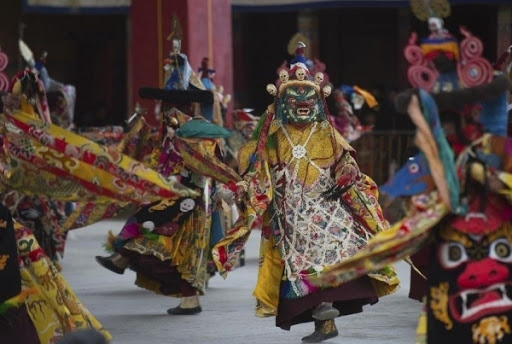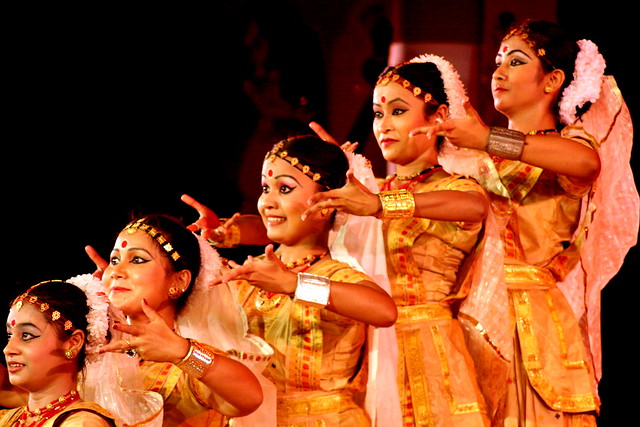World Dance Day 2021 – 12 Indian Dance Forms Going Extinct
Related Articles
BMC Election 2026: Aam Aadmi Party का बड़ा ऐलान, मुंबई की सभी 227 सीटों पर अकेले लड़ेगी ‘आप’
BMC Election 2026 Aam Aadmi Party: मुंबई की राजनीति में बड़ा उलटफेर करते हुए आम आदमी पार्टी (AAP) ने बीएमसी चुनाव 2026 को लेकर...
OBC Status of North Indian in Mumbai: बीएमसी इलेक्शन आते ही याद आये मुंबई में उत्तर भारतीय OBC समाज
एकनाथ शिंदे करेंगे सीधा संवाद, आरक्षण पर खुल सकती है गांठ
मुंबई में रहने वाले उत्तर भारतीय ओबीसी समाज के लिए 20 दिसंबर 2025 का...
Investment in UP: यूपी में होगा ₹6500 करोड़ का निवेश, 25 कंपनियां तैयार, योगी से मिले दिग्गज उद्योगपति
लखनऊ में मुख्यमंत्री योगी आदित्यनाथ से 25 बड़ी कंपनियों के 45 शीर्ष प्रोफेशनल्स ने मुलाकात की और उत्तर प्रदेश में करीब ₹6500 करोड़ के...


 From the valleys of Tibet comes Cham, a collective form of mystical dances that date back 1300 years. Tibetan Buddhist monks dress up in colourful masked costumes and perform ancient moves, for deliverance from evil. Cham has many historical and mystical anecdotes associated with it. Nowadays the local population of the Himalayas is declining, as many of the families want to have lesser children, citing economic reasons. With just one or two children, families are hesitant to send their children to monasteries. Hence lesser number of children are becoming monks. If not passed, Cham might become extinct soon.
From the valleys of Tibet comes Cham, a collective form of mystical dances that date back 1300 years. Tibetan Buddhist monks dress up in colourful masked costumes and perform ancient moves, for deliverance from evil. Cham has many historical and mystical anecdotes associated with it. Nowadays the local population of the Himalayas is declining, as many of the families want to have lesser children, citing economic reasons. With just one or two children, families are hesitant to send their children to monasteries. Hence lesser number of children are becoming monks. If not passed, Cham might become extinct soon. Nati mainly originated from Kullu district in Himachal Pradesh. There are seven different forms of Nati dances performed by Himachali youth such as Lahauli Nati, Kinnauri, Sirmauri, Mahasuvi and Himachali Nati dance. Although it was listed as the largest folk dance in the Guinness Book of World Records in 2016, Nati is fast disappearing from our culture. This dance form is also known as ‘Losar shone chuksom’ indicating the local New Year celebrations in Himachal.
Nati mainly originated from Kullu district in Himachal Pradesh. There are seven different forms of Nati dances performed by Himachali youth such as Lahauli Nati, Kinnauri, Sirmauri, Mahasuvi and Himachali Nati dance. Although it was listed as the largest folk dance in the Guinness Book of World Records in 2016, Nati is fast disappearing from our culture. This dance form is also known as ‘Losar shone chuksom’ indicating the local New Year celebrations in Himachal. This was one of the famous dances that originated from Odisha. Gotipua emerged as long back as the 16th Century. The term is used to depict the words ‘single boy’ and was a rite of passage for young boys when they reached adolescence. They’d dress up as women and dance Gotipua in praise of Lord Jagannath and Lord Krishna. But with time, the dress along with the makeup was modified, and this transition led to the more contemporary Odissi dance.
This was one of the famous dances that originated from Odisha. Gotipua emerged as long back as the 16th Century. The term is used to depict the words ‘single boy’ and was a rite of passage for young boys when they reached adolescence. They’d dress up as women and dance Gotipua in praise of Lord Jagannath and Lord Krishna. But with time, the dress along with the makeup was modified, and this transition led to the more contemporary Odissi dance. Chhau is a tradition from the eastern states of India. It has three distinct styles, each from the regions of Seraikella, Purulia and Mayurbhanj. Chhau is considered a martial art and has tribal roots, which explains the elaborate masks. The term is the Sanskrit word for “chaaya” that means shadow. It is a rare mythological dance that has very powerful moves, and various weapons are used including swords and arrows.
Chhau is a tradition from the eastern states of India. It has three distinct styles, each from the regions of Seraikella, Purulia and Mayurbhanj. Chhau is considered a martial art and has tribal roots, which explains the elaborate masks. The term is the Sanskrit word for “chaaya” that means shadow. It is a rare mythological dance that has very powerful moves, and various weapons are used including swords and arrows. Chaiti Ghora is a festival celebrated in April. The dance has great potential from ethnological perspective. The practice of horse worship in the form of Baseli and its conversion into Goddess Laxmi might provide insight on various aspects. Folklore collected from Balasore district shows that it has roots in the maritime traditions of Orissa. The dance involves dummy horses on male performers. They recite the Kaibarta Gita, a treatise written by saint Achyutananda Das in 16th century.
Chaiti Ghora is a festival celebrated in April. The dance has great potential from ethnological perspective. The practice of horse worship in the form of Baseli and its conversion into Goddess Laxmi might provide insight on various aspects. Folklore collected from Balasore district shows that it has roots in the maritime traditions of Orissa. The dance involves dummy horses on male performers. They recite the Kaibarta Gita, a treatise written by saint Achyutananda Das in 16th century. Sattriya or “dashabtar” is a rare dance credited to the guru, Srimanta Sankaradeva. The initial form contained the depiction of mythological stories. The dance was formally recognized as a classical Indian dance form in the year 2000. It’s inspired from the folk as well as the traditional dances of the states from Northeast India, especially Assam.
Sattriya or “dashabtar” is a rare dance credited to the guru, Srimanta Sankaradeva. The initial form contained the depiction of mythological stories. The dance was formally recognized as a classical Indian dance form in the year 2000. It’s inspired from the folk as well as the traditional dances of the states from Northeast India, especially Assam. The term Guar stands for Bison, and the dance begins with the sound of a bamboo horn. The sound of drums and horns is matched in step by women holding long sticks in their hands. They cross their male partners throughout the Gaur Maria dance. They make visually stunning formations. The animalistic touch is seen in both the dance movements as well as the costumes.
The term Guar stands for Bison, and the dance begins with the sound of a bamboo horn. The sound of drums and horns is matched in step by women holding long sticks in their hands. They cross their male partners throughout the Gaur Maria dance. They make visually stunning formations. The animalistic touch is seen in both the dance movements as well as the costumes. The performers narrate a Hindu epic poem like the Ramayana and Mahabharata. However, there is a comedy act incorporated into the dance where the narrator encourages audience members to speak or perform. He also alludes to current social-economic problems and relates them to our ancient lifestyles in dance form.
The performers narrate a Hindu epic poem like the Ramayana and Mahabharata. However, there is a comedy act incorporated into the dance where the narrator encourages audience members to speak or perform. He also alludes to current social-economic problems and relates them to our ancient lifestyles in dance form. Nagaland is blessed with myriad ancient tribes, which boast their own war dances and specialised costumes. Fakrant and Fojima-Fona are just two among many. Fojima-Fona is performed with a sword and shield. The warrior is asked to stand below a tree with a nest of red insects in his hand. The warrior moves his sword around his body with great speed so that the insect does not fall on him.
Nagaland is blessed with myriad ancient tribes, which boast their own war dances and specialised costumes. Fakrant and Fojima-Fona are just two among many. Fojima-Fona is performed with a sword and shield. The warrior is asked to stand below a tree with a nest of red insects in his hand. The warrior moves his sword around his body with great speed so that the insect does not fall on him. Non-Christian Khasi in Shillong are associated with this dance. The dance is called Shad Suk Mynsiem and translates to ‘Dance of the Happy Soul’, performed by young unmarried boys and girls, of course. The boys put on a Pagri and Dhoti with a traditional jacket. They dance with swords in their hands. The girls wear a special metallic headband called Pankhiliat. This is a slow dance with many musical instruments – Bishi (flute), Kabang (drum) and Tangmuri (long flute).
Non-Christian Khasi in Shillong are associated with this dance. The dance is called Shad Suk Mynsiem and translates to ‘Dance of the Happy Soul’, performed by young unmarried boys and girls, of course. The boys put on a Pagri and Dhoti with a traditional jacket. They dance with swords in their hands. The girls wear a special metallic headband called Pankhiliat. This is a slow dance with many musical instruments – Bishi (flute), Kabang (drum) and Tangmuri (long flute). The bamboo dance is all about rhythm. One misstep and your feet will hit the stick hard. A set of 4-6 bamboos, about 8 feet long each, are placed parallelly on the ground. Two people sitting at both ends will move the sticks closer and farther from each other at a particular rhythm while young girls dressed in their traditional best, jump in and out of the spaces. There are two steps in this dance: Kant Luang and Khawti. This continues for hours, with the dancers keeping rhythm with the clapping sound of the bamboo logs.
The bamboo dance is all about rhythm. One misstep and your feet will hit the stick hard. A set of 4-6 bamboos, about 8 feet long each, are placed parallelly on the ground. Two people sitting at both ends will move the sticks closer and farther from each other at a particular rhythm while young girls dressed in their traditional best, jump in and out of the spaces. There are two steps in this dance: Kant Luang and Khawti. This continues for hours, with the dancers keeping rhythm with the clapping sound of the bamboo logs. This dance is performed to the accompaniment of a long log drum carried by the drummer by means of a string across his shoulders. The dance is comparatively slow with slow body movement. Male dancers put on special costumes – a turban on the head, a jacket and a lower garment.
This dance is performed to the accompaniment of a long log drum carried by the drummer by means of a string across his shoulders. The dance is comparatively slow with slow body movement. Male dancers put on special costumes – a turban on the head, a jacket and a lower garment.